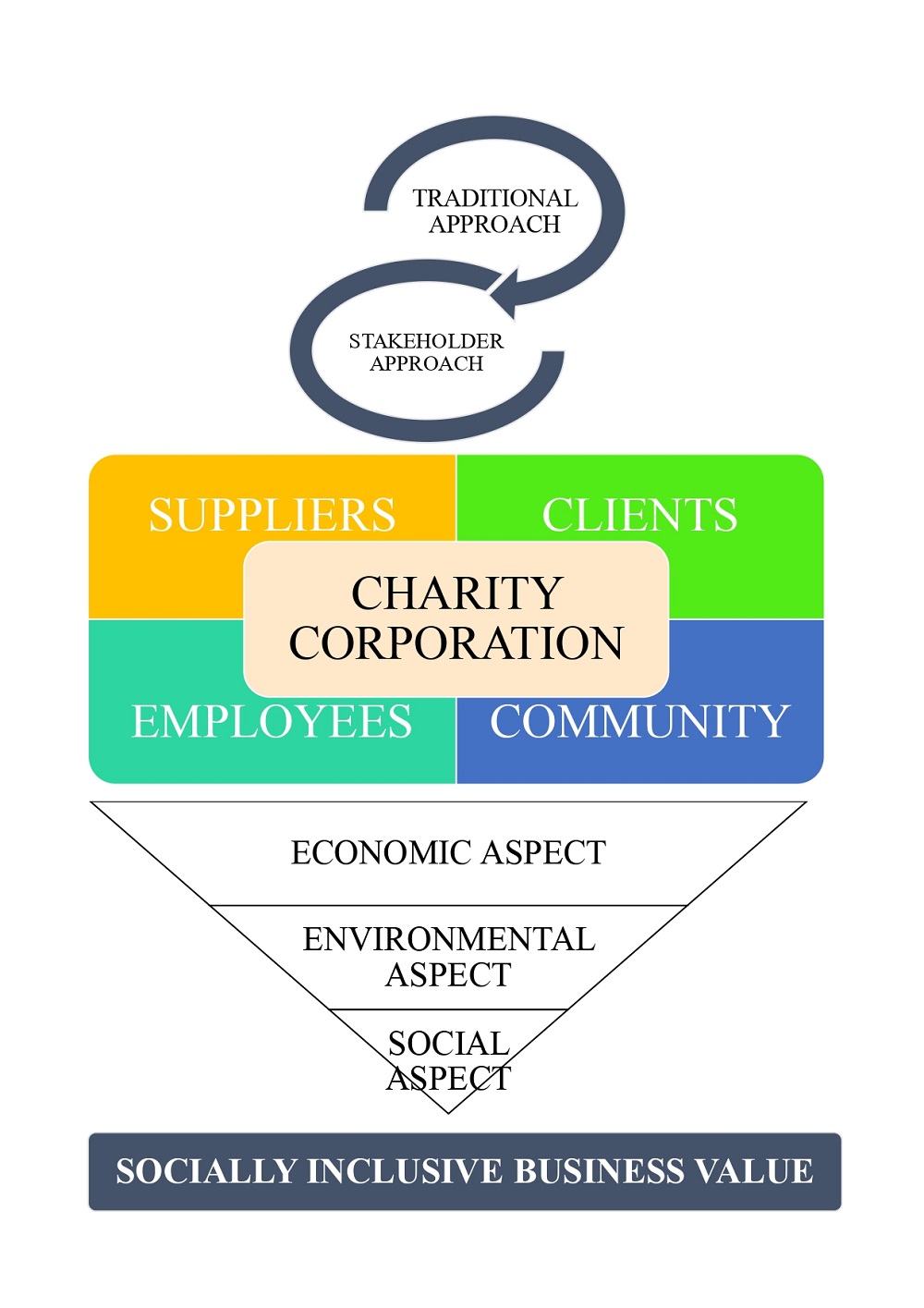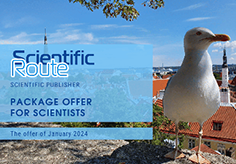Розробка соціально-орієнтованої інклюзивної бізнес-моделі стратегічного оновлення підприємства
DOI:
https://doi.org/10.15587/1729-4061.2023.292500Ключові слова:
корпоративна філантропія, стейкхолдерський підхід, суспільно-інклюзивна цінність, благодійна корпораціяАнотація
Об’єктом дослідження є бізнес-модель стратегічного оновлення підприємств за напрямками економічності, екологічності та соціальності. Ключова проблема: необхідність розробки контурів бізнес-моделі стратегічного оновлення підприємств, максимально адаптованої до сучасних викликів ринку і суспільства. На основі передумов про еволюцію традиційних корпоративних стратегій до стейкхолдерського підходу сформована бізнес-модель стратегічного оновлення підприємства. Визначено і обгрунтовано відносницький характер бізнес-активності компаній, напрямки трансформації методів аналізу і підходів до прийняття рішень, а також ключові елементи, вектори та результат взаємодії в межах розробленої бізнес-моделі. Показані можливості практичного застосування соціально-орієнтованої інклюзивної бізнес-моделі при здійсненні бізнес-аналізу. Інтерпретація результатів дослідження: соціально-орієнтована бізнес-модель стратегічного оновлення підприємства розроблена на основі систематизації відносницького підходу, теорій зацікавлених сторін та корпоративної філантропії, концепції «благодійної корпорації» та орієнтації на суспільно-інклюзивну цінність замість традиційної акціонерної вартості. Поряд із традиційним економічним аспектом бізнес-моделі окреслено екологічний та соціальний аспект. Для адаптації бізнес-моделей підприємств до сучасних викликів запропоновано збільшити використання якісних параметрів аналізу при реалізації стратегічних рішень, а також здійснювати проєктування розвитку відносин із ключовими стейкхолдерами. Практичне значення: визначені параметри бізнес-моделі можуть бути використані підприємствами для проведення критичного аналізу власних бізнес-стратегій і розробки ефективних заходів щодо їх адаптації до сучасних викликів.
Посилання
- Rasheed, A., Ion, W. (2022). A Novel Approach towards Sustainability Assessment in Manufacturing and Stakeholder’s Role. Sustainability, 14 (6), 3221. doi: https://doi.org/10.3390/su14063221
- Schmitt, A., Barker, V. L., Raisch, S., Whetten, D. (2016). Strategic Renewal in Times of Environmental Scarcity. Long Range Planning, 49 (3), 361–376. doi: https://doi.org/10.1016/j.lrp.2015.08.004
- Rowley, T. J. (1997). Moving Beyond Dyadic Ties: A Network Theory of Stakeholder Influences. Academy of Management Review, 22 (4), 887–910. doi: https://doi.org/10.5465/amr.1997.9711022107
- Westerveld, P., Fielt, E., Desouza, K. C., Gable, G. G. (2023). The business model portfolio as a strategic tool for value creation and business performance. The Journal of Strategic Information Systems, 32 (1), 101758. doi: https://doi.org/10.1016/j.jsis.2023.101758
- Halonen, N., Majuri, M., Lanz, M. (2019). Characteristics of a circular economy framework to support strategic renewal in manufacturing firms. Procedia CIRP, 81, 653–658. doi: https://doi.org/10.1016/j.procir.2019.03.171
- Hill, C. W. L., Jones, T. M. (1992). STAKEHOLDER‐AGENCY THEORY. Journal of Management Studies, 29 (2), 131–154. doi: https://doi.org/10.1111/j.1467-6486.1992.tb00657.x
- Gautier, A., Pache, A.-C. (2015). Research on Corporate Philanthropy: A Review and Assessment. Journal of Business Ethics, 126 (3), 343–369. doi: https://doi.org/10.1007/s10551-013-1969-7
- França, C. L., Broman, G., Robèrt, K.-H., Basile, G., Trygg, L. (2017). An approach to business model innovation and design for strategic sustainable development. Journal of Cleaner Production, 140, 155–166. doi: https://doi.org/10.1016/j.jclepro.2016.06.124
- Aravindakshan, A., Rust, R. T., Lemon, K. N., Zeithaml, V. A. (2004). Customer equity: Making marketing strategy financially accountable. Journal of Systems Science and Systems Engineering, 13 (4), 405–422. doi: https://doi.org/10.1007/s11518-006-0173-z
- Omtzigt, J. D. (2009). Survey on Social inclusion: Theory and Policy. Available at: https://www.semanticscholar.org/paper/Survey-on-Social-inclusion-%3A-Theory-and-Policy-1-of-Omtzigt/946cdbe95e393a4b020b93c4f06c98e9f72e1f9b
- Chakravorti, B., Macmillan, G., Siesfeld, T. (2014). Growth for Good or Good for Growth: How Sustainable and Inclusive Activities are Changing Business and Why Companies Aren’t Changing Enough. Available at: https://www2.deloitte.com/content/dam/Deloitte/us/Documents/monitor-institute/us-monitor-institute-growth.pdf
- von Schönfeld, K. C., Ferreira, A. (2021). Urban Planning and European Innovation Policy: Achieving Sustainability, Social Inclusion, and Economic Growth? Sustainability, 13 (3), 1137. doi: https://doi.org/10.3390/su13031137
- Malnight, T. W., Buche, I., Dhanaraj, C. (2019). Put purpose at the core of your strategy. Harvard Business Review. Available at: https://hbr.org/2019/09/put-purpose-at-the-core-of-your-strategy
- Castells, M., Caraca, J., Cardoso, G. (Eds.) (2012). Aftermath: The Cultures of the Economic Crisis. Oxford: Oxford University Press.
- Kramarenko, A. (2021). Social innovations and business: essence, opportunities, business models. Efektyvna Ekonomika, 9. doi: https://doi.org/10.32702/2307-2105-2021.9.73
- Freeman, R. E. (2004). The Stakeholder Approach Revisited. Zeitschrift Für Wirtschafts- Und Unternehmensethik, 5 (3), 228–241. doi: https://doi.org/10.5771/1439-880x-2004-3-228
- Garlewicz, K. (2018). How To Care For Your Stakeholders For Better Business Health. Forbes. Available at: https://www.forbes.com/sites/theyec/2018/10/11/how-to-care-for-your-stakeholders-for-better-business-health/?sh=7761ff6221cf
- Hess, M. F., Hess, A. M. (2016). Stakeholder-Driven Strategic Renewal. International Business Research, 9 (3), 53. doi: https://doi.org/10.5539/ibr.v9n3p53
- Geels, F. W. (2011). The multi-level perspective on sustainability transitions: Responses to seven criticisms. Environmental Innovation and Societal Transitions, 1 (1), 24–40. doi: https://doi.org/10.1016/j.eist.2011.02.002
- Elliott, J. (2009) Sustainable development. International Encyclopedia of Human Geography. Oxford: Elsevier, 117–131. doi: https://doi.org/10.1016/b978-008044910-4.00124-3
- Marcus, A. (1989). The deterrent to dubious corporate behavior: Profitability, probability and safety recalls. Strategic Management Journal, 10 (3), 233–250. doi: https://doi.org/10.1002/smj.4250100304
- Marquis, C. (2020). Is Your Business Ready For Stakeholder Capitalism? Forbes. Available at: https://www.forbes.com/sites/christophermarquis/2020/07/29/is-your-business-ready-for-stakeholder-capitalism/?sh=31b0b0935ec0
- Barney, J. B., Wright, P. M. (1998). On becoming a strategic partner: The role of human resources in gaining competitive advantage. Human Resource Management, 37 (1), 31–46. doi: https://doi.org/10.1002/(sici)1099-050x(199821)37:1<31::aid-hrm4>3.0.co;2-w
- Delaney, J. T., Huselid M. A. (1996). The Impact of Human Resource Management Practices on Perceptions of Organizational Performance. Academy of Management Journal, 39 (4), 949–969. doi: https://doi.org/10.2307/256718
- Arora, P., Petrova, M. (2010). Corporate social performance, resource dependence and firm performance. Journal of Business Economics, 1, 1–22. doi: https://doi.org/10.2139/ssrn.1364993
- Amit, R., Schoemaker, P. J. H. (1993). Strategic assets and organizational rent. Strategic Management Journal, 14 (1), 33–46. doi: https://doi.org/10.1002/smj.4250140105
- Brammer, S. J., Pavelin, S., Porter, L. A. (2009). Corporate Charitable Giving, Multinational Companies and Countries of Concern. Journal of Management Studies, 46 (4), 575–596. doi: https://doi.org/10.1111/j.1467-6486.2008.00827.x
- Campbell, J. L. (2007). Why would corporations behave in socially responsible ways? an institutional theory of corporate social responsibility. Academy of Management Review, 32 (3), 946–967. doi: https://doi.org/10.5465/amr.2007.25275684
- Arco‐Castro, L., López‐Pérez, M. V., Pérez‐López, M. C., Rodríguez‐Ariza, L. (2020). How market value relates to corporate philanthropy and its assurance. The moderating effect of the business sector. Business Ethics: A European Review, 29 (2), 266–281. doi: https://doi.org/10.1111/beer.12264
- Porter, M. E., Kramer, M. R. (2011). Creating shared value. Harvard Business Review. Available at: https://hbr.org/2011/01/the-big-idea-creating-shared-value
- Grubor, A., Berber, N., Aleksić, M., Bjekić, R. (2020). The influence of corporate social responsibility on organizational performance: A research in AP Vojvodina. Anali Ekonomskog Fakulteta u Subotici, 43, 3–13. doi: https://doi.org/10.5937/aneksub2001003g
- Felber, C., Campos, V., Sanchis, J. R. (2019). The Common Good Balance Sheet, an Adequate Tool to Capture Non-Financials? Sustainability, 11 (14), 3791. doi: https://doi.org/10.3390/su11143791
- Figge, F., Shaltegger, S. (2000). What is stakeholder value? Developing a catchphrase into a benchmarking tool. Published in association with United Nations Environment Program.
- Porter, M. E., Kramer, M. R. (2002). The Competitive advantage of corporate philanthropy. Harvard Business Review. Available at: https://hbr.org/2002/12/the-competitive-advantage-of-corporate-philanthropy
- Coskun-Setirek, A., Tanrikulu, Z. (2021). Digital innovations-driven business model regeneration: A process model. Technology in Society, 64, 101461. doi: https://doi.org/10.1016/j.techsoc.2020.101461
- Coffay, M., Bocken, N. (2023). Sustainable by design: An organizational design tool for sustainable business model innovation. Journal of Cleaner Production, 427, 139294. doi: https://doi.org/10.1016/j.jclepro.2023.139294
- Rong, K., Wu, J., Shi, Y., Guo, L. (2015). Nurturing business ecosystems for growth in a foreign market: Incubating, identifying and integrating stakeholders. Journal of International Management, 21 (4), 293–308. doi: https://doi.org/10.1016/j.intman.2015.07.004
- Ivascu, L., Cirjaliu, B., Draghici, A. (2016). Business Model for the University-industry Collaboration in Open Innovation. Procedia Economics and Finance, 39, 674–678. doi: https://doi.org/10.1016/s2212-5671(16)30288-x

##submission.downloads##
Опубліковано
Як цитувати
Номер
Розділ
Ліцензія
Авторське право (c) 2023 Anna Kramarenko, Anton Kvitka

Ця робота ліцензується відповідно до Creative Commons Attribution 4.0 International License.
Закріплення та умови передачі авторських прав (ідентифікація авторства) здійснюється у Ліцензійному договорі. Зокрема, автори залишають за собою право на авторство свого рукопису та передають журналу право першої публікації цієї роботи на умовах ліцензії Creative Commons CC BY. При цьому вони мають право укладати самостійно додаткові угоди, що стосуються неексклюзивного поширення роботи у тому вигляді, в якому вона була опублікована цим журналом, але за умови збереження посилання на першу публікацію статті в цьому журналі.
Ліцензійний договір – це документ, в якому автор гарантує, що володіє усіма авторськими правами на твір (рукопис, статтю, тощо).
Автори, підписуючи Ліцензійний договір з ПП «ТЕХНОЛОГІЧНИЙ ЦЕНТР», мають усі права на подальше використання свого твору за умови посилання на наше видання, в якому твір опублікований. Відповідно до умов Ліцензійного договору, Видавець ПП «ТЕХНОЛОГІЧНИЙ ЦЕНТР» не забирає ваші авторські права та отримує від авторів дозвіл на використання та розповсюдження публікації через світові наукові ресурси (власні електронні ресурси, наукометричні бази даних, репозитарії, бібліотеки тощо).
За відсутності підписаного Ліцензійного договору або за відсутністю вказаних в цьому договорі ідентифікаторів, що дають змогу ідентифікувати особу автора, редакція не має права працювати з рукописом.
Важливо пам’ятати, що існує і інший тип угоди між авторами та видавцями – коли авторські права передаються від авторів до видавця. В такому разі автори втрачають права власності на свій твір та не можуть його використовувати в будь-який спосіб.









